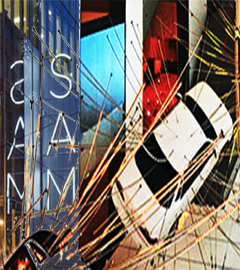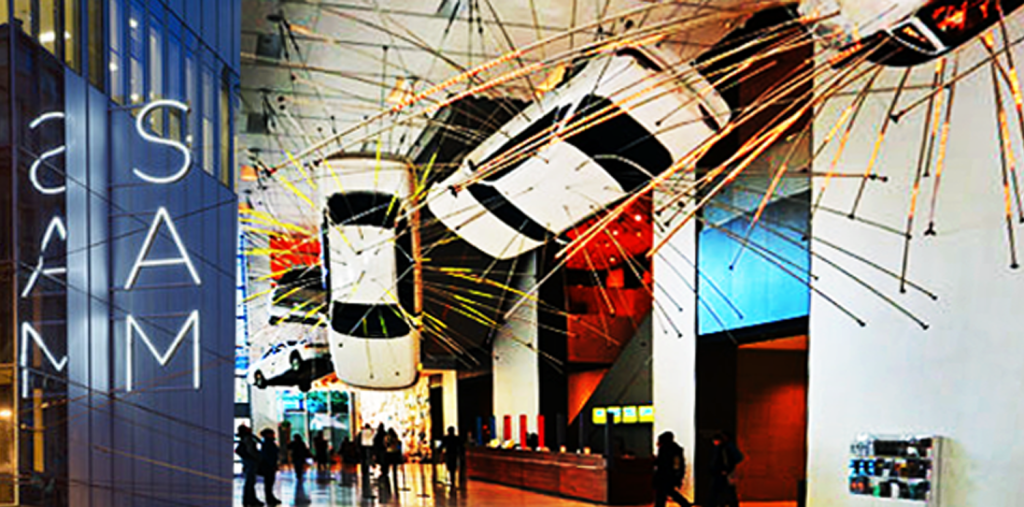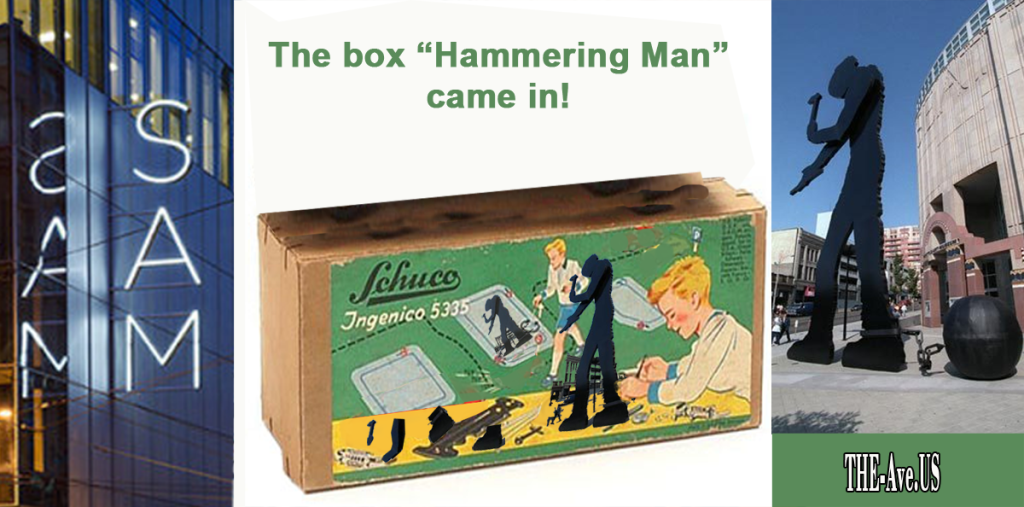
 I love the ORIGINAL Seattle Art Museum, the ORIGINAL SAM. The collection of “Asian” art is a wonderful statement of both the divers art of what is not Europe but of the taste of Dr. Fuller.
I love the ORIGINAL Seattle Art Museum, the ORIGINAL SAM. The collection of “Asian” art is a wonderful statement of both the divers art of what is not Europe but of the taste of Dr. Fuller.
I am, therefore. offended by the way the folks who run the Seattle “”Art” Museum expropriated those letters for their downtown emporium.” I need to close my eyes walking into the place out of fear that a Ford Falcon will fall on my head. The entry to the real art in the collection (a lot of which I love) is blocked by a hall full of the latest stuff donated by rich folks with dubious taste but very cleaver tax attorneys. At least now the stupid thing. have finally been taken down ,, not that the donor has not already spent his or her tax benefit.
Calling Dr. Fuller’s beautiful museum the “Seattle Asian Art Museum” is an insult. If anything the letters SAAM should be used for the Seattle Ain’t Art Museum, the one with the idiotic hanging cars (above) and the overgrown “Hammering Man.” This tourist attraction is nothing more than an overgrown sheet metal wind up toy. “made in Japan” toy from post WWII made in Japan. (if you look closely at the base it is inscribed “made in USA.”
So, in this spirit or old Jewish guy artistic outrage I was pleased last April to read this simpatico piece by a like minded critic ar Raw Story:
Sola Agustsson, AlterNet (excerpted)
Here are 7 reasons why the contemporary art world is an insufferable scam — corrupted by the super-rich
“My grandmother is an African-American assemblage artist, and my mother and aunt are artists as well. …. ….I never managed to really write as an art critic; I was more like a junior copywriter for art.
…. I got to interview art collectors, gallery dealers, models, artists, and designers who probably spend more on handbags than I do on rent. I’ve sipped champagne in a Bentley and feasted on caviar in penthouse apartments. Though I disliked some of the art I was assigned to cover, as a grad student I couldn’t really be choosy about what I wrote about. I wanted to get published, and getting paid to write, no matter the topic, felt like a blessing.
Here are the main reasons why the art world nauseates me.
1. Art collectors treat art as an investment.
For the most part, the only people who can afford to buy art in this economy are people who are not affected by this economy, the top 1 or 2 percent. Of course, rich people have always patronized the arts— Michelangelo would never have been able to produce his masterpieces without the Medici family— but today’s billionaires aren’t just patronizing artists, they’re investing in and branding them. The top 10 billionaire art collectors have 18% of their net worth invested in art, though the average billionaire invests about .5% of their net worth in art. Investing in art can sometimes prove more lucrative than the stock market; a recent study shows that works by Andy Warhol and Damien Hirst have been appreciating at a higher rate than the S&P 500.
There is money to be made not just in selling art, but also in evaluating its worth. In the same way a financial advisor would help you make investment choices, there are art advisors who counsel your art purchases. “Appearing as if from nowhere, like a biblical swarm of locusts: The art advisors…. in the last few years, advisors have popped up literally everywhere and now outnumber collectors 2 to 1,” says financial writer Adam Lindermann. Many contemporary art collectors have no interest in the art itself, making priceless works of art nothing more than fetishized commodities.
Flipping, selling artworks immediately after purchasing them at exponential prices, is also a common practice among art collectors. Many financial advisors predict that continuing to inflate the value of works of art that are constantly turned over will soon cause the art bubble to burst. “The auction houses are experiencing a situation where every auction total is higher than the last and these vertiginous upward prices cannot be maintained forever. Someday the music is going to stop and somebody is going to be found without a chair to sit on,” says art expert and former Sotheby’s employee Todd Levin.
2. Art is a spectacle.
There are certain exhibitions, like James Turrell’s immersive light installation at the Guggenheim, when experiencing the art everyone is extoling is nearly impossible because there are so many viewers clamoring to see what the hype is about. I waited in line for nearly two hours to see Turrell’s Aten Reign, a “meditative spectacle” where I “may or may not see God” (according to New York Times critic Roberta Smith). Perhaps I would have seen God had not every New Yorker who had that day off been breathing down my neck, but mostly, the entire exhibit seemed like a subtle joke. There I was, standing in a line, shuffling up the steps like a prisoner, waiting to see this transformative work that no matter how spectacular would ultimately frustrate me. Perhaps I’m cynical, but the crowded wait only ruined the exhibit for me. I wondered if this wasn’t some kind of existential funhouse, a metaphor for the futility of human existence, ending in a disappointing light show.
3. Conceptual art is a joke.
Half of the so-called conceptual art I see makes me wonder if the artist is trolling everyone. I often find myself at odds when reading the press release of an exhibit and looking at the actual work, thinking, this person read some basic critical theory, threw together a bunch of objects, and hastily applied some absurd meaning that they themselves cannot fully explain. Maybe I’m old-fashioned, but so much of the art I see is forgettable, like a messy dream I can’t quite articulate.
4. Art factories steal souls.
More and more, highly successful artists are relying on mass production factories to produce their masterpieces. There’s nothing wrong with hiring others to help with the artistic process—this has been done for centuries. But artists like Jeff Koons who employ hundreds of workers to complete their works without ever laying a single brushstroke on the canvas (because that might upset the artistic decision-making process) have turned Warhol’s concept of the factory into an artistic dystopia. People are paying millions of dollars for eyesore animal balloon sculptures that were produced by Koons’ underpaid art serfs, who are fired if they do not complete their painstaking tasks exactly as assigned. I believe creative people should turn their own suffering into art, not cause other people’s suffering with their art.
5. Art school is kind of a scam.
Mike Kelley once said of the recent boom in art school enrollment, “Young people who would have previously gone into careers in indie rock—which is one of the few arenas where a young person with no particular talent can make some money—can now accomplish the same thing in the art world.” But going to art school doesn’t guarantee success in the art world, and art schools often cater to certain artistic movements, isolating those who don’t fit into current trends.
6. Women artists and artists of color are sidelined.
Twenty years after the Guerrilla Girls feminist art group criticized major art museums for their lack of gender and racial diversity, little has changed. Women still need to be naked to get into the Met (4% of women artists make up the modern section of the Metropolitan Museum and 76% of paintings of nudes are female), and white male artists dominate the commercial art world for the most part. It is rare to see a large museum feature a person of color in a solo exhibition—Carrie Mae Weems was the first African-American woman to get a solo show at the Guggenheim museum in 2014.
7. Money for art in public schools is dwindling.
There isn’t a lack of money being funneled through the art universe, but public school budgets for art programs are always the first to be cut. Art education has many benefits in child development, including encouraging motor skills, visual learning, decision-making, and inventiveness. If even a fraction of the billions of dollars spent on art went into children’s education, it would make a positive difference in the richness of children’s lives and the diversity of the art world.

